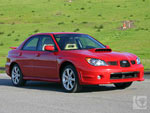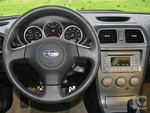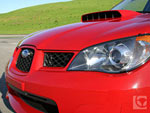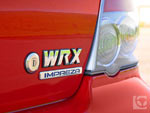 My first memory of the Subaru Impreza WRX: carving up eight twisty race tracks at 140 MPH, shredding tires, crashing into various walls and cars, and in the end, consistently whooping my best lap times earned in a Corvette, Supra, Skyline, RX-7, 300ZX, or NSX. OK, so all this was achieved with my left and right thumbs in front of a 20-inch dorm room TV, but hey, Gran Turismo is the ultimate driving simulator, is it not?
My first memory of the Subaru Impreza WRX: carving up eight twisty race tracks at 140 MPH, shredding tires, crashing into various walls and cars, and in the end, consistently whooping my best lap times earned in a Corvette, Supra, Skyline, RX-7, 300ZX, or NSX. OK, so all this was achieved with my left and right thumbs in front of a 20-inch dorm room TV, but hey, Gran Turismo is the ultimate driving simulator, is it not?I figured if the real thing were half as good, I had to have it. Apparently I wasn't alone: that 1998 PlayStation staple has been cited as the cause of Subaru's most impressive Impreza selling 230% as well as planned after arriving four years later. Things have gotten tougher since then - the WRX got an actual competitor and the automotive version of Moore's Law dampened its impact - but Subaru isn't about to let its living legend slip.
They've changed at least one big thing every year since its launch. Two years ago it spawned a 300-horsepower brother; last year it got an interior makeover; this year's revisions are best seen from the outside. More prominent are the mechanical upgrades for all Imprezas, with the 2006 WRX in particular enjoying enough engineering to almost qualify as a new car.
Road Test

One constant dating back to 1993 is the WRX's standing as an undercover authority figure. Any street racer making assumptions about this unassuming little sedan got his reward in the form of a dropped jaw and a crushed ego as its driver rocketed out of sight. Driving a WRX has always been the nonverbal way to say "You boys better gather up your VTECs, turbo Eclipses, and 5.0 Mustangs and move your little league over to some other park. This is a man's game now."
Turbocharging makes this possible. You may have seen turbos in your time, but how many of them crammed twice the pressure of the atmosphere into four little cylinders (via a Mitsubishi turbocharger, irony of ironies)? The mention of 227 horsepower doesn't blow minds like it did in 2002, but you don't think much about paper specs when you're out in the real world thrusting out of corners or past entire herds of cars, all while listening to that vivid roar exclusive to engines whose cylinders lie sideways. And admit it: 5.4 seconds to 60 is still fast.
For 2006, the power rushes in sooner and stronger now that the other Subarus have chosen to share their 2.5-liter engine block with the formerly 2.0-liter WRX. While bore and stroke both rise in tandem (92mm to 99.5; 75mm to 79), the three extra horsies (now 230 in all) find themselves overshadowed by the 18 additional pounds-feet of torque. The healthy new supply of 235 cures the weak-kneed feeling from its low-speed operations.
Putting all that power to the ground is never a problem when you channel them through all four wheels, which in this case also helps handling. Isn't handling this car's greater talent anyway? AWD exploits every last iota of grip from this year's bigger P215/45R17 tires (though their all-season tread limits potential), and a rear end that's easy to slide around guarantees you'll have a fun time trying. Steering that sends clear signals to your hands and has been sped up for quicker response this year are further points in the WRX's favor.
All this news might hint at a hyperkinetic no-compromises race car. Not so. Despite the rising sport quotient, the WRX never had much interest in your suffering. Aside from the occasional sharp snap or harsh landing, the WRX's quartet of struts eats up bumps in a manner nearly as civil as a normal Impreza. At 70 MPH, the new big engine spins at a reasonable 2,600 RPM and road noise is never a big deal, possibly thanks to this year's noise reduction measures (underbody cover, more insulation in the carpet and headliner). Oddly, the one standout in the NVH department is wind noise that turns almost violent as 100 MPH draws near; blame the [functional] hood scoop and frameless doors for that one.
The WRX's potential is pretty down-to-Earth, too. Smooth steering, brake, and accelerator inputs promote quick man-machine bonding, and this editor enjoyed slamming the new "short-throw" shifter (still seems tall) through its gates. Unlike Mitsubishi did with its Lancer Evo, Subaru didn't spoil the stickshift experience with a recalcitrant clutch; the WRX's left pedal is gradual and forgiving. Another difference: its turbocharger isn't heard from as often due to its circa-3,500 RPM activation point (and because of higher natural torque, it doesn't need to be), which would explain how our WRX's very decent 24 MPG (mostly freeway) beat our smaller-engined Evo. (The flipside: Mitsubishi's turbo is more fun to activate.) Finally, after failing to find Subaru's mushy brake feel (new front and rear rotors are bigger by 0.1" and 1.0"), I gave up looking for a serious flaw in the WRX driving experience.
So it found me. There I am, cruise controlling my way down Interstate 5 at 80 MPH when my speed starts sagging and fluctuating between the 60s and 70s, shortly thereafter surging past the mid-80s. After a minute of this, I hit Cancel, take the helm, and all sanity is restored. But another minute passes and speed starts tapering off again, this time robbing me of all accelerative ability. I then perform two frantic lane changes to reach the shoulder, and on my unsteady descent to a stop I notice my check engine light present, my power steering absent. I think I recall some other dashboard lights, but my mind was focused on other matters. Like my mortality.
The WRX is as fun in person as it is in pixels. Just remember that in real life, there is no reset button.
Inside & Out

The Impreza heads into its fifth year already on its third pair of headlights, taillights, and wheels. From the original car's ugly moon eyes to 2004's chunky iceblocks to this Tribeca-like snout, it marks a slow but steady styling evolution. Maybe by 2008, it could be beautiful.
Aside from the now-standard 17-inch wheels and the STI's adoption of the WRX's smaller hood scoop (for visibility reasons), the only other mentionable regarding the body is the light and fluffy feel of those frameless doors and trunk. Cost-cutting? Probably, but at least they, plus the aluminum hood, help the WRX maintain its 3,239-pound figure.
The WRX's interior mostly follows Impreza status quo. The new three-spoke Subaru steering wheel (a Momo wheel's still optional) looks and feels as good to your hands as the drilled aluminum pedals do to your feet. An ideal driving position comes easily (unlike on some sporty cars like the stubbornly reclined Acura RSX) in a height-adjustable driver's seat with effective side support. The crisp displays would be perfect if not for the steering wheel blocking the upper edge of the perching tachometer. Dual-stage front air bags and body-and-head side airbags for the front seat are substantial safety enhancements for the year. If Subaru would just show half as much concern for rear passengers (for starters, how about some head restraints?), we could call this car safe.
Cockpit controls are your typical 90s-style Japan layout - intuitive, high quality, shallow cupholders. Cruddy gray dashboard plastic abounds, though the WRX Limited shifts your attention to one of the nicer leather interiors at this price. Another such item is the stereo. Too many systems try to show off with wattage, speaker count, or overemphasized bass; the 140-watt WRX comes out ahead by balancing crisp lows, mids, and highs into a very fulfilling soundstage. However, that overly reflective display screen has to go; we need a tuning knob that actually works like one (instead of a toggle switch in drag); and Subaru's still slacking by not giving MP3 playback or an Aux jack for portable players. With Subaru's young, educated customer base, you'd think that would be obvious.
The Impreza's EPA-certified "subcompact" status explains the back seat's lame legroom and why three passengers congeal into one miserable mold. It even looks small from the outside, but if you judge before you sit, you'll never discover the high, firm seat cushion lending superb support, all that stomping room under the front seats, a comfortable armrest right in the middle, and a floor hump no bigger than a front-wheel-drive car's. As long as no one's stuck being the middleman and everyone's under six feet, the Impreza is actually quite the fine four-seater. There goes the Impreza again, surpassing expectations set up by appearances and empirical data.
The hinged, 11 cubic foot trunk is pretty average for the class, containing a center pass-through to the cabin but no folding rear seat ability. That's another rare omission in this class, though it might have been intentional to keep this sporty car stiff.
Other Thoughts

This Impreza has been a three-tier lineup for a while, and there's always been lots to keep track of. This year, the base model Impreza 2.5RS (remember when it was top of the line?) changes its name to 2.5i to mimic Subaru's Legacy, and gets Active Valve Lift (valve timing) to raise horsepower to 173. Starts at $18,920.
It takes at least $5,700 more to ascend up to 230-horsepower society, now stratified into the WRX TR ($24,620), WRX ($25,620), and WRX Limited ($28,120). To the TR, the middle WRX adds fog lights, body color mirrors, performance seats, rear cupholders, passenger's seatback pocket, automatic climate control, leather steering wheel / shifter / handbrake, and upgrades the 80-watt 4-speaker CD player to a 140-watt 6-speaker CD changer - not bad for $1,000. The WRX Limited then adds heated leather seats, moonroof, heated mirrors, wiper de-icer, and spoiler.
Both also come in wagon form, multiplying cargo space up to 23.8 / 61.6 cubic feet (back seat up / down). Non-turbo Imprezas take the forms of the 2.5i Sport Wagon, raised-up Outback Sport, or Outback Sport Special Edition. The WRX and WRX Limited wagons inexplicably come $500 cheaper than the sedans.
Up in the performance stratosphere is the WRX STI (that's now a capital "I"), lowering the car by 0.8 inches but otherwise raising the bar with a 6-speed manual (only choice), 17x8-inch BBS wheels, Super Sport Brembo brakes, stiffened and inverted struts, and front crossmember bar. The greatest upgrade is in power and torque, which the STI raises to 300 / 300 while pumping a mere 1 psi of extra turbo boost (14.5 vs. 13.5) into the same basic engine.
The all-wheel-drive system changes as much as the powertrains as you jump around the model map. While all Imprezas drive all wheels all the time, cars with the 4-speed automatic ($800) employ a more sophisticated and electronically-controlled transfer clutch, which on the WRX sends 55% of the power backward by default. Subaru is silent on the split for non-turbo models, which probably means they, unappealingly, send 90% of the power forward like the first Impreza did.
Manual cars instead employ a simpler viscous coupling that splits the power 50/50 on all non-turbo and WRX models. The STI gets Subaru's best, an Active Controlled Center Differential that sends 59% backward (vs. 65% last year) and lets the driver flip a switch to make that 50/50 at will. When it comes to limited-slip differentials at the ends of the car, WRXs get a viscous one in the rear that the base models lack. The STI then swaps that for a mechanical type, then adds a helical-type differential to the front.
Whew.
This amazingly diverse line of little cars turns monotonous when it comes to being a killer deal. Let's start with the 2.5i. Because its price, content, and performance are right in line with the Mazda 3 s and Mitsubishi Lancer Ralliart, Subaru's almost giving all-wheel-drive away for free. It's not that AWD is necessarily desirable (for most people, it's just a waste of gas and power) but the going rate for that stuff is usually a cool thousand bucks or two.
Even the $33,620 STI doesn't sound so steep considering that it, along with the Mitsubishi Evo, can far outrun any car at its price point and quite a few above it (including a coupled named "Porsche").
Same story with the middleman WRX, which beats the pants off dedicated sports cars like the Acura RSX, Nissan 350Z, Mazda RX-8, Honda S2000, and everything else on down. One car under $30,000 is faster: the Mustang GT. But the Mustang's a 2-seater, 3-season car while the WRX is 4 for 4. Which would you want for your only car?
Last Word

All-wheel-drive isn't for everyone, but it's hard to argue with a performance car that gets decent mileage, a driver's car that doesn't shortchange passengers, a foul-weather friend, and an all-around fantastic value. The Impreza WRX is all of the above. At least when the engine works.[ source : automotive.com]
Post a Comment